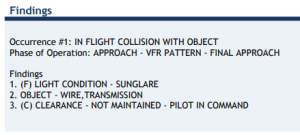If you’re going IFR to linden in real IFR weather, think twice about this. If flying is inherently dangerous, and if approaches to minimums are the most dangerous part of flying, then this particular approach is a compound. This approach should never be attempted by new IFR pilots with weather near minimums. If you’re a seasoned IFR pilot, keep reading.
Newark Approach will force you to cancel IFR between the FAF and MAP. The MAP is the first opportunity to maybe see the runway. That means you’re always cancelling IFR before you have visual contact with the runway, and you cannot go missed.
Recall that VFR minimums in Golf daytime is 1sm vis and clear of clouds. That means in daytime, as long as you have 1sm vis and can remain clear of clouds, legally, you can cancel IFR and continue the approach legally VFR pilot nav.
Visibility is the most important thing. It’s 2.3nm from BAUTZ to the runway. So if visibility is less than 2.3nm you know you won’t be able to see the runway when you pass through the FAF and turn towards the airport. When you pick up the AWOS, make a note of this “see/no-see’ factor.
The IAP published minimums are 620′ and 2.5nm. So they want you to see at least the REIL at BAUTZ. But you’ve cancelled by then so you’re committed to do *something* and you better see the runway and fly a true direct course to it on runway heading maintaining altitude, doing anything else is extremely dangerous in those weather conditions and in that geographic area.
Now I would avoid at all costs flying this at minimums in low vis, but if you must, it’s possible to do relatively safely with a trick I’m going to teach you.
You see, what we really have here is an incomplete approach. It is a GPS-A because of newark arrivals, otherwise it would be a GPS approach, lined up with runway. They don’t want planes going missed right into the approach corridors of EWR.
But, with a small trick we can reconfigure the approach so the autopilot will fly us all they way to the runway.
In your flight plan, after MAP BAUTZ insert KLDJ as a waypoint. The autopilot will now turn right at BAUTZ and fly directly to the runway. You are at 620′ so don’t start descending yet. At 500fpm descent, it will take 1 minute to get to the threshold, in which time you’ll travel about 1.5nm. The runway is 4200′ long, or approximately 1sm.
On your GPS flight plan when you load the KLDJ GPS-A procedure you’ll see:
GEZSY (FAF)
3NM TO BAUTZ
BAUTZ (MAP)
VANER
and you want to change it to this:
GEZSY (FAF)
3NM TO BAUTZ
BAUTZ (MAP)
KLDJ <– INSERT
VANER
Now the autopilot will make that turn at BAUTZ direct to the runway and we have GPS distance and time remaining. However, the KLDJ waypoint is in the MIDDLE of the runway, not the approach end. We know the runway is 4140′ (round to 1sm for simplicity). Subtract 0.5nm or 20 seconds to get the actual distance and/or time to the threshold. So when the GPS says 1.5nm remaining, you’re actually only 1nm from the threshold.
Now you can use the seconds remaining and NM remaining to KLDJ to determine when you should start normal descent, and you’ll know exactly where to look for the runway. You’ll be on autopilot, you won’t be hand flying and doing crazy stuff. Just fly the approach normally. Lined up with the runway, the approach will be much easier to fly, and runway easier to see with this technique, and you won’t accidentally start descent too early and fly into a factory. (check NTSB for several fatal accidents that start early descend into LDJ). If you’re planning a 500fpm descent, then 60+20=80 seconds remaining to KLDJ is when you want to begin your 500fpm descent to the threshold, no sooner.

The key for unfamiliar pilots is to not even try this approach if visibility is < 2.5nm. You know you won’t be able to see the runway when you turn out of BAUTZ.
With this reprogrammed GPS set up you’ll be less likely to try to hand fly it or descend too early or get disoriented. You should not disengage the autopilot until you’re in a position for a normal descent to the runway, which is about 1/3 of the way between BAUTZ and the runway.
It’s good to think about the worst case scenario too, where you can’t land. I would make a normal 180 degree turn to the right, away from EWR, fly the missed approach, radio ATC or EWR Tower and calmly tell them you need immediate IFR clearance, climbing through 1000′ over LDJ direct VANER. You’re flying away from newark so they won’t panic. .
Warning: there are tall towers and factory chimneys right below the extended center line, so do not begin descent until you have positive visual contact with the runway, and can see the terrain below you. It’s NJ, so lights don;’t always work, be especially cautious at night. Note that this procedure is NA at night.
It goes without saying, you should practice this first under VFR conditions. Use every opportunity with VFR weather to fly this approach as practice so when clouds are low you’ll be ready.
Fatal Accidents at LDJ
“THE ACFT HIT THE TOP OF A 75′ TREE & CRASHED JUST SHORT OF THE FAF. A WITNESS RPRTD THAT JUST BFR THE ACDNT, THE ACFT APPEARED TO ‘POP OUT’ OF A CLOUD AT ABT 100′ AGL IN A DSCNT”

